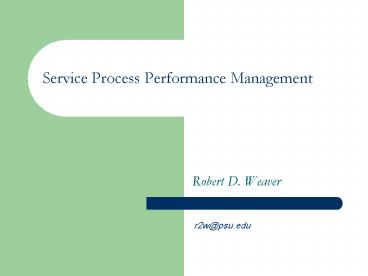Service Process Performance Management PowerPoint PPT Presentation
1 / 30
Title: Service Process Performance Management
1
Service Process Performance Management
- Robert D. Weaver
r2w_at_psu.edu
2
Processes, Performance, Incentives
- The setting and the implications for service
management - Examples
- Current research potential for applications
- Example application projects
- Bottomline the potential
3
The setting
- Services provision involve complex processes
- Not typically linear
- Not typically based on fixed production rules
- Performance results from
- Human agent interaction
- Human agent management of resources, other
agents, clients - Achievement of performance requires
- Metrics to quantify and monitor
- Incentives direct agents
4
The issue How to manage performance?
- Management of service processes is fundamentally
different from manufacturing processes - Service processes
- Involve agents
- Agents are multifunctional and interactive
- Agents are self-directive implying control is not
direct - Agents embody tacit knowledge that is critical
to performance - Process performance often depends on
collaboration among agents
5
Service performance management
- Two steps
- Define, implement, and monitor performance
metrics of the service system - Overall system performance
- Agent performance
- Process performance
- Design, implement, and monitor incentives that
drive agent performance to achieve system goals
6
Step 1 Service process performance
- Salient features of service processes
- Role of agents
- Metrics for performance
7
Service systems are not linear
Marketing Sales
Technical Service
Outbound Logistics
Production
8
Service process characteristics
- Processes are fuzzy
- Semi-autonomous human agents
- Interact
- Loosely follow rules that describe process ideals
- Apply material and time inputs
- Respond to continuum of problem settings
- Agents manage subprocesses that compose a
service system to deliver value
9
Service system configurations Simple cases
10
Service system configurations
11
Service system configurations
12
Service system configurations
13
Role of agents in service system
- Many agents
- Agent have decision-making capacity
- Agent goals affect decisions
- Agent manage sub processes
- Agents interact and are interdependent
- Monitoring is costly and imperfect
14
Characteristics of agents within a service system
- Directed by process rules
- Capable of decision-making in response to change
in problem setting - Guided by personal goals and resources that may
include service system goals (alignment) - Influenced by incentives
15
Types of agent interaction
- Asset service sharing
- Tactical integration joint modification of
traditional silo operations to enhance
collaborative performance - Strategic integration
16
Multi-agent service system
17
Example Major League Baseball
18
What metrics for service performance?
- Metrics are simply indicators of performance
- Three types needed
- Agent performance
- Process performance
- Service system performance
- Performance must be defined by service system
strategic goals and subsidiary objectives - Quantifiable measures of necessary conditions for
performance levels acheivement.
19
Prerequisites for metrics
- Observable
- Verifiable
- Low cost/value
- High frequency
- Leading indicators of service system goals
20
Examples of metrics
- Efficiency of resource use
- Fill rate, response delay, client revisions
- Financials typicals, cash-to-cash turn rates,
21
Example Major League Baseball
22
Why performance metrics?
- Monitoring for management
- Gauging net benefits of agent configuration
- Sharing net benefits through incentives
- Monitoring for diagnostics
- Identify opportunities for improvement
- Identify bottlenecks, new problems
- Establish opportunities for response
- Metrics form basis for incentive design
23
Step 2 Incentive design
- Align agent service system goals
- Manage agent performance
24
Alignment of goals
- Incentives signal service system goals
- Incentives encourage alignment
- Salary level
- Promotions
- Bonuses (cash, options)
25
Need for managing agent performance
- Agent autonomy creates bases for incentive design
- Agent performance may be difficult monitor on a
continuous basis - Agent potential (quality) difficult to measure
- Agent performance varies across agents
- Ultimately, agent performance reflects some
voluntary human behavior !
26
Potential of incentives
- Differential incentives encourage productivity
where pay-off will be greatest - Incentive package can induce agent to
- Reveal true quality
- Perform at potential
- Incentive package design can align agent with
service system goals - Incentive package design can be done at the
system level
27
Nature of the beast
- Choose incentives conditional on metrics
- Dynamic, stochastic optimization of service
system goals, given - Service system process
- Agent autonomy and optimization
28
Potential pay-offs
- Uniform incentives across heterogeneous agents
fail to induce goal achievement - Differential incentive packages provide means of
inducing agents to contribute to system
performance
29
Service system process management
- Summary
30
Three stages of research
- Service system mapping
- Characterize system processes, agents, and flows
of effort that lead to delivery of service - Performance metric design
- Derive metrics from service system strategic
goals and system structure - Incentive design

